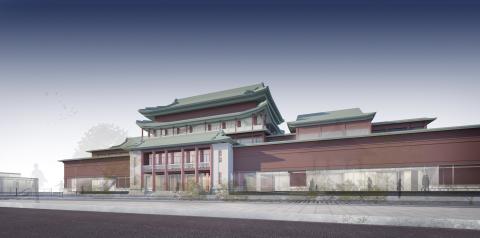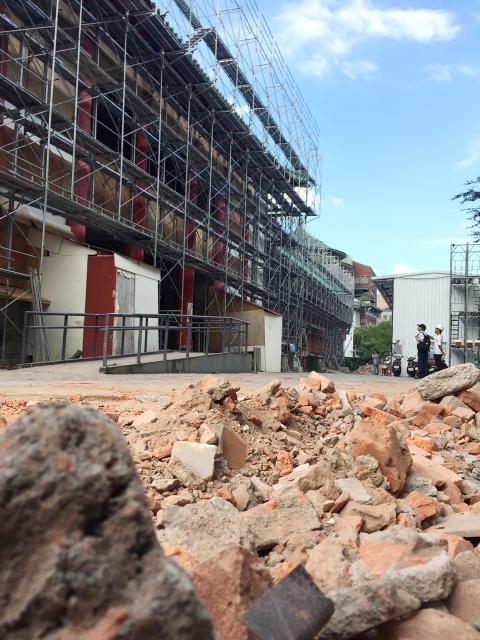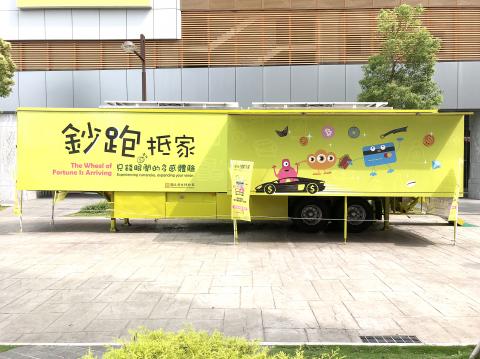In its 63 years, never before has the National Museum of History undergone such a large project. Staff anxiously crowded around a truck in July last year as the museum’s director sealed its doors in the first of 25 trips to move 63,000 artifacts, the entirety of the museum’s collection.
For three years, most of the pieces will sit in storehouses across the country, safe from vibration and dust as the museum undergoes badly needed renovations and excavators carve an MRT tunnel next door. It is a long time for a museum to be closed, but could be a boon for this institution that is eager to redefine itself.
“In the past, it was very much the cultural representation of the Republic of China, but after 63 years, everything is getting old, things change, people’s cultural tastes changed,” director Liao Hsin-tien (廖新田) told the Taipei Times.

Photo courtesy of the National Museum of History
Some visitors might come away from the museum a little confused about its vision. Its past charge as Chiang Kai-shek’s (蔣介石) bastion of Chinese culture has bequeathed treasured cultural artifacts, yet also a confusion of identity.
The museum was established after World War II as part of the Chinese Nationalist Party’s (KMT) “Nanhai cultural area” (南海學園), which aimed to Sinicize Taiwanese culture. Although Taiwan’s national identity has evolved, the museum is still tasked with pinning down the history its name promises, yet with largely the same collection.
The result has been disjointed, with Chinese artifacts presented separately from contemporary art exhibitions, a kind of portmanteau of the National Palace Museum and National Museum of Taiwan History in Tainan. Without having fully broken from this “Chinese Cultural Renaissance” (中華文化復興運動) past, it is slipping away from newer generations.

Photo: Kayleigh Madjar, Taipei Times
“We’ve found out that we can’t attract young people to our museum because of our collection, because of the way in which we express ourselves,” Liao said. “We want to connect with the young generation ... to express the message that in the future, when we open, this museum is for everyone.”
MOBILE MUSEUM
Across the country, a truck is parked near Yanfeng Elementary School in Nantou County, a cartoon face based on an ancient bronze stands smiling from the sides. Children clamber inside to solve puzzles and view 3D models of the piece that inspired the cartoon and other treasures from the museum’s collection.

Photo courtesy of the National Museum of History
The bright colors and energetic games are a departure from the image most people have of the institution, although this mobile museum and its partner have been traveling the country for 18 years, reaching 1.15 million children.
Previously a lesser known part of its programming, these trucks now represent the kind of interaction the museum hopes to foster.
“We are not a spider anymore. We are a bee,” Liao said. “We fly out and take pollen back and create honey, but a spider just waits there.”
Without its web, the museum has had to get more creative about how to spin connections.
Among other projects, it has created a mascot based on the cartoon bronze that the staff calls “Mr Cool,” and has been pushing image licensing and cultural industry collaboration in the hopes of freshening its image.
The staff is also venturing out to communicate with educators and other groups to see what they need and would actually use in order to create programming that would better serve the public.
Of course, the grand jewel of this rebranding will be the renovated museum itself, which is projected to open at the end of 2021.
MODERNIZED MUSEUM
With modernized amenities, thematic floors, a newly-dug international conference hall and more space with the staff and storage moved off site, Liao envisions a “kind of rebirth or metamorphosis” that can bring together the two parts of the museum’s collection.
“I want a permanent exhibition at the National Museum of History that can represent Taiwan. Not only Chinese culture, because we have different cultures,” he said, describing his hopes for the new third floor named after the massive collaborative painting Formosa Evergreen (寶島長春).
While the museum will still feature its treasured sancai (三彩, polychrome) pottery and bronzes, the plan is to place them alongside a carefully curated collection to provide a more comprehensive vision of Taiwan that includes Indigenous people, different genders, migrant groups and others who are also part of Taiwanese history.
“My mission is not to divide things, but to put things together. Not to mix them up, but connect things... Because this society has different cultures and we mix things together,” Liao said.
In the meantime, the museum’s artifacts will not entirely be hidden away in storage. To solve the practical issue of space and in the spirit of connection, the museum has partnered with various institutions, including the National Palace Museum and Academia Sinica, to conduct research and their own exhibitions.
Notably, the Henan bronzes can be viewed at Academia Sinica’s Institute of History and Philology until they are returned to the museum, while the new Tainan Art Museum is presenting Formosa Evergreen until Oct. 13. This year alone, the museum is holding 12 exhibitions at other institutions nationwide, while five are so far on the docket for next year.
Even after the museum itself reopens, part of it will have to wait even longer. Experts believe that artifacts are buried beneath the museum, a theory supported by finds workers are unearthing as they dig the new MRT line. The underground conference hall is expected to face similar delays as archeologists carry out excavation work, but Liao is excited to turn the delay into another opportunity.
“There will be some kind of living museum in front of our museum,” he said, laughing as he envisioned visitors peering over the side of a pit and watching archeologists at work.
The two guardian lions that flank the museum’s entrance — perhaps the only in the world to protect a national museum — will remain where they are during the renovation. The first director ordered them built after they appeared to him in a dream, promising to safeguard his museum. They now stand behind wooden boards, themselves protected from the construction happening around them.
Once revealed, the museum will highlight their story as part of a larger narrative about how many of its artifacts are rooted in the struggles over Taiwanese history. Yet the original mission they represent — “protectors of artifacts, promoters of culture” (文物的保護者, 文化的發揚者) — is to remain the same.

Oct. 27 to Nov. 2 Over a breakfast of soymilk and fried dough costing less than NT$400, seven officials and engineers agreed on a NT$400 million plan — unaware that it would mark the beginning of Taiwan’s semiconductor empire. It was a cold February morning in 1974. Gathered at the unassuming shop were Economics minister Sun Yun-hsuan (孫運璿), director-general of Transportation and Communications Kao Yu-shu (高玉樹), Industrial Technology Research Institute (ITRI) president Wang Chao-chen (王兆振), Telecommunications Laboratories director Kang Pao-huang (康寶煌), Executive Yuan secretary-general Fei Hua (費驊), director-general of Telecommunications Fang Hsien-chi (方賢齊) and Radio Corporation of America (RCA) Laboratories director Pan
The consensus on the Chinese Nationalist Party (KMT) chair race is that Cheng Li-wun (鄭麗文) ran a populist, ideological back-to-basics campaign and soundly defeated former Taipei mayor Hau Lung-bin (郝龍斌), the candidate backed by the big institutional players. Cheng tapped into a wave of popular enthusiasm within the KMT, while the institutional players’ get-out-the-vote abilities fell flat, suggesting their power has weakened significantly. Yet, a closer look at the race paints a more complicated picture, raising questions about some analysts’ conclusions, including my own. TURNOUT Here is a surprising statistic: Turnout was 130,678, or 39.46 percent of the 331,145 eligible party

The classic warmth of a good old-fashioned izakaya beckons you in, all cozy nooks and dark wood finishes, as tables order a third round and waiters sling tapas-sized bites and assorted — sometimes unidentifiable — skewered meats. But there’s a romantic hush about this Ximending (西門町) hotspot, with cocktails savored, plating elegant and never rushed and daters and diners lit by candlelight and chandelier. Each chair is mismatched and the assorted tables appear to be the fanciest picks from a nearby flea market. A naked sewing mannequin stands in a dimly lit corner, adorned with antique mirrors and draped foliage

The election of Cheng Li-wun (鄭麗文) as chair of the Chinese Nationalist Party (KMT) marked a triumphant return of pride in the “Chinese” in the party name. Cheng wants Taiwanese to be proud to call themselves Chinese again. The unambiguous winner was a return to the KMT ideology that formed in the early 2000s under then chairman Lien Chan (連戰) and president Ma Ying-jeou (馬英九) put into practice as far as he could, until ultimately thwarted by hundreds of thousands of protestors thronging the streets in what became known as the Sunflower movement in 2014. Cheng is an unambiguous Chinese ethnonationalist,